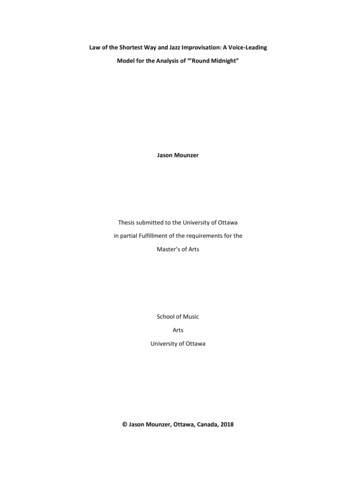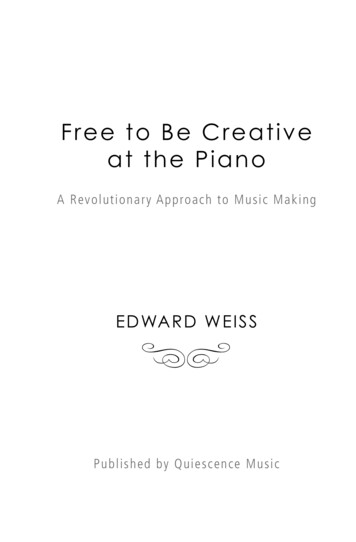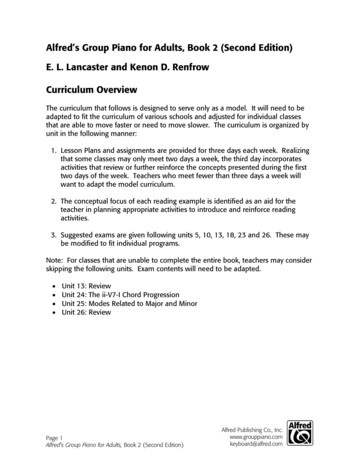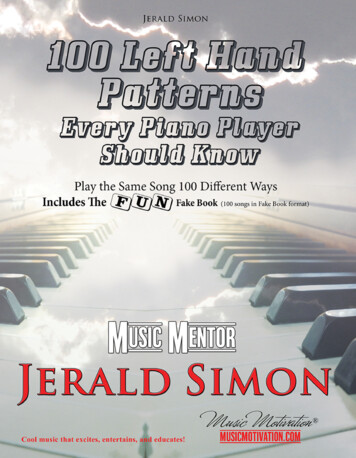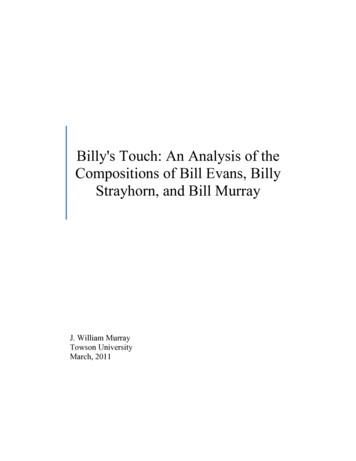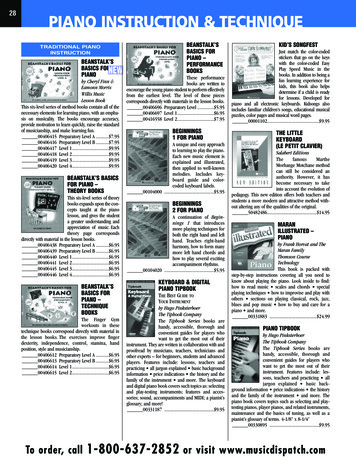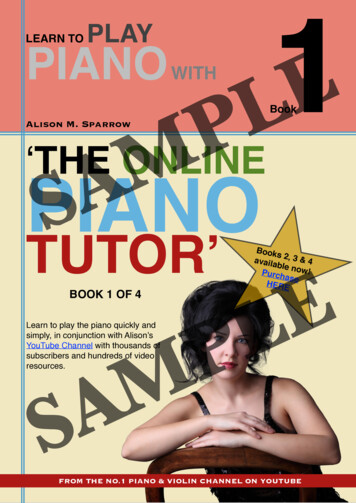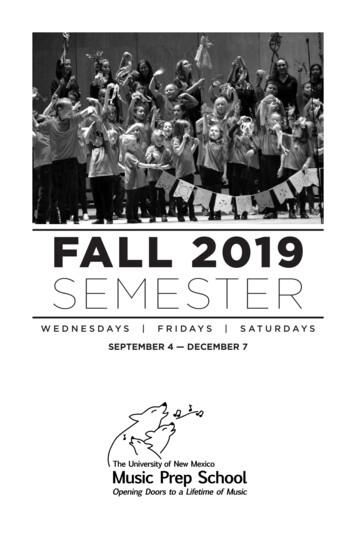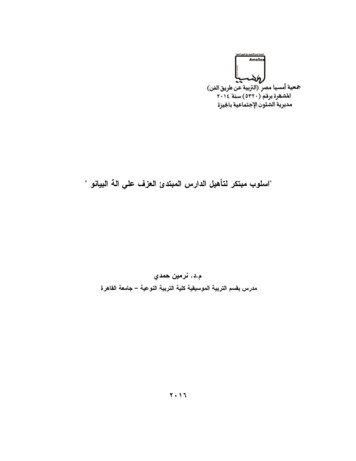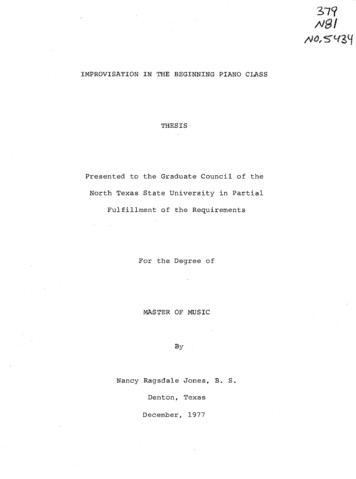
Transcription
I-7IMPROVISATION IN THE BEGINNING PIANO CLASSTHESISPresentedto the Graduate Council of theNorth Texas State University in PartialFulfillmentof the RequirementsFor the Degree ofMASTER OF MUSICByNancy RagsdaleJones,Denton,TexasDecember,1977B.S.
Jones, Nancy Ragsdale, Improvisation in the Beginning Piano Class.December, 1977.159 pp.,Master of Music (Music Education).bibliography, 96 titles.The problem was to survey and collect ideas on the use ofimprovisation as a teaching and learning tool in elementary piano instruction and to prescribe activities and exercises for second throughfourth grade piano classes.These areas were examined: philosophiesand theories influencing traditional instruction, effects of creativekeyboard activities on children's musical development, specific teachingstrategies using improvisation, evaluative procedures, and suitabilityof materials for young children.Data collected from published and unpublished materials wereclassified, and presented concerning the feasibility of using keyboardimprovisation with early elementary children.It was found thatsuitable improvisational exercises allow the child to organize hisperceptions into the basic concepts of music.teachers and researchers were made.Recommendations for
TABLE OF CONTENTSPageINTRODUCTION . .ChapterI.Statement of the ProblemDefinition of TermsDelimitationsBasic AssumptionsBackground for the StudyMethodologyPlan for the ReportChapter BibliographyII.IMPROVISATION IN HISTORY:THEORY AND PRACTICE.19The Rise of ImprovisationThe Decline of ImprovisationCurrent Learning TheoriesSummaryChapter BibliographyIII.CREATIVITY IN TEACHING AND LEARNING.39Basic Principles of CreativityCreative Experiences Through ImprovisationEliciting Creative BehaviorMusic Reading and CreativityContemporary Idioms in Improvisational ActivitiesSummaryChapter BibliographyIV.TECHNIQUES FOR TEACHING AND EVALUATINGIMPROVISATION . . . . . . . . . . .Optimum Age for Improvisation InstructionRhythmic ImprovisationMelodic ImprovisationHarmonic ImprovisationFormal ImprovisationStylistic ImprovisationAdditional Activitiesiii.69
PageEvaluationEvaluative ProblemsEvaluative ProceduresImprovisation as an Evaluative ToolSummaryChapter BibliographyV.MATERIALS AND RESOURCES FOR USE IN TEACHINGIMPROVISATION .106Teaching MaterialsPedagogical ResourcesSummaryChapter BibliographyVI.SUMMARY,FINDINGS, AND RECOMMENDATIONS .APPENDICES. 145APPENDIX A:SELECTED MATERIALS FOR USE IN TEACHINGIMPROVISATIONAPPENDIX B:CRITERIA FOR EVALUATING MATERIALS ONIMPROVISATION TO BE USED INCHILDREN"S PIANO CLASSESBIBLIOGRAPHY.iv127. 150
CHAPTER IINTRODUCTIONOne of the inconsistencies of music teaching in the pastwasthat although music was claimed to be one of the creativearts,it was rarely taught that wayJulia Broughton,in Success(23,p.516).in Piano Teachingplified the particular spiritIn 1956,(5,p.99),exem-toward creativity in pianoinstruction prevalent at that time when she observedthat"those who strongly advocate creative work have had very littleexperience.in actual piano teaching.deal of creative work is a waste of time.and I thinkWe might betterturn our efforts toward something more practical."Hetty Bolton,in her text On Teaching the Piano,two short paragraphs on playingThen in 1963,teachers have oftenauthority,E.(3,p.40).Paul Torrance wrote that althoughinsisted itis more economical to learn byindicated that man fundamen-tally prefers to learn in creative ways -questioning,and modifying ideasIn 1954,included butsimple tunes by earthe results of researchmanipulating,a great(28,p.experimenting,12).In fact,be growing interest in creativity as1by exploring,risking,testing,there continues toit relates to music
l2education.There has been considerable interest in the act ofcreation itself,the process underlyingit,characteristics ofcreative people, -andmethods showing how to elicit creativeactivityFew teachers,(9,p.3).however,art's historical significance or of itsties,and are,for the most part,are aware of theeducational possibili-unprepared to meet theimplications of the development of the increasedrecognition of the art of improvisationone of the reasons thatdecline is(8,p.interest and1-2).Perhapsimprovisation has been allowed tothat many instructors avoid teachingimprovisationdue to a weakness in this part of their own backgroundMuch has been writtenin thep.7).field of piano pedagogyregarding the development of technical proficiency;there(13,however,is ample evidence which indicates that skill develop-ment does not necessarily lead to musicalPerhaps,insight(17,p. 19).through active experimentation with sounds andstructures,the student can discoverfor himself those conceptsof organization and interaction which are fundamentalto musi-cal understanding.To date,numerous systemsincorporating ideas of bothYale Seminar and recent educationalA common elementthefindings have been presented.in all these music education curricula is theuse of improvisation and music creativity.Although more
3emphasis is on the acquisition of well-rounded musicianship,improvisation unfortunately playslittle or no part todaytraining of the average piano student(15,p.38).One major aspect of modern teaching is thediscovery as a learning procedure.Indeed,in thetrend towardthe most generallyaccepted theory of American music education today is that studentsshould discover musical principles through their own explorationand manipulation of sound(14,p.115).methods would seem to be coming abouttors including a shiftment,Changes in teachingas a result of severalfac-in the attitude toward reward and punish-a realization that thefunction and play of childrenisexactly the same as learning about themselves and the world aboutthem,and a realizationthat knowledge must be presented in aninteresting manner which is suited to the child's own interests,aptitudes and abilities(9, p.5).Music educators are also recognizing the problemsin the use of improvisation with children,difficulty in evaluating creative behavior.should be evaluated:tively simple),attitudescognition(almost impossible),one of which is theSpecifically,(quite difficult),(spotty at best),involvedskillswhat(rela-aesthetic sensitivityor a combination of all these things?evaluation to be a part of the learning experience,remain an external factor?or isIsit to
l4Another problem faced by piano teachers who arein incorporating improvisationalinterestedactivities into theirlessonsis the lack of resource material geared toward the earlyelementary age child.been producedtextsand method books havefor the adult beginner in pianopiano on the collegeinstructionNumerouslevel for piano minors)in the functionalskills deemed(generally classwhich offerso essential to athorough knowledge of music.These contain in varying degreesome material and suggestionsforadaptable to the young student.improvisation which areOn the other hand, while jazzhas brought about a renaissance in improvisation,books deal-ing with jazz improvisation generally offer very few activitiessuitable forany but a rapidlyadvancing older student with afull-sized hand.There is a needoffer suggestionsand opportunities,for appropriate materialand stimulate enthusiasmfor improvisation which would be suitable for usening piano classesIn summary,in grades two,the need fortothree,in begin-and four.this study was influenced bythe growing interest in the study of music creativity andimprovisation as a teaching and learning tool and the suggestedneedfor a better understanding of these terms as they relateto piano instruction today.It is hoped that by collecting anumber of ideas on creative keyboard activitiesfrom a variety
5of sources it will be possible to synthesize those ideas into aworkable guideline that might be useful to teachers interestedin using improvisation in their lessons.This survey will also endeavor to present a guide to theavailable resources and teaching materials on the subject,andoffer a compilation of specific pedagogical routines to aid theteacher in the pursuit of an effective and efficient methodology.Statement of the ProblemThe purpose of this study wasto survey and collectideason the use of improvisation as a teaching and learning tool inelementary piano instruction and to prescribe specific activitiesfor the implementation of these ideas with seven-to nine-year-old children in the first year of study in a piano classsetting.1.The answers to thefollowing questions were sought:What are the attitudestoward music creativity thatare held by music education specialists and piano pedagogues,and how do these attitudes affect the use of improvisation inpianostudy?2.forcedWhat specific musical concepts can bein the weekly piano class by the use oftaught or reinimprovisationas an educational tool and can the results be evaluated?3.What materialsand resourcesare available to aid thepiano instructor in incorporating improvisation into the beginning
6piano class and how can they be utilized or implemented?Definition of TermsThe term improvisationrefers to spontaneous music-makingwithout the aid of manuscript or memory,a creative musicalact demanding instant musical decisions.Groves dictionarysuccinctly definesimprovisation asperforming music simultaneously""the art of thinking and(7,p.991).Itis charac-terized by subconscious use of concepts with skillsemotion at the same moment and demandsan active relationshipbetween the imagination and the keyboard.cians make use of "building blocks,"combining,recombining,Improvising musi-choosingand rearranging themfrom among them,(21,Ferand- refers-to improvisation as :"the spontaneousand shaping of music while it is being performed"and distinguishes between strictand freeformer refers to the alteration of orandp.13).invention(11, p.improvisation.Improvisation,then,Thethe addition to an al-ready existing composition at the moment of execution.latter implies simultaneous5),invention and performanceThe(11,p.is the discovery of new relationshipsofsounds and the ordering of these relationshipsinto a varietyof expressive combinations and patterns.Theterm improvisational activity refers to a creativeexercise lasting aboutten minutesin which students perform6).
7music extemporaneously at the keyboard within teacher-imposedlimits,either alone orIn this type of activityprearrangedso that allis sometimes referredin ensemble with other class members.some areas of the framework have beenfactors are notimprovised at once.Thisto as planned improvisation in which thestudent has the freedom to change or rearrange only one or twoof the basic elements of music while retaining the others in aprearranged structure orform.The term piano class refers to four or more students ofapproximately the same age and proficiency level meeting onceeach week and using either the electronic piano lab or conventional pianos.for theThe class experience inimprovisation providesfree exchange of musical ideas and learning among stu-dents.The term musical development refers to the growth of anindividual in the cognitive and affective areas of learning,including the acquisition of the conceptsmusic,and employing creativity as anof the elements ofintegral part of learning.The purpose of combining the cognitive and affective domains inteaching is to usethe former to explainening aesthetic awareness andmusical growth.judgment,the latter,thus height-and providing skillsThe essence of musical developmentis thebuilding of a stable framework of musical concepts through afor
8progressive organization of experiences.Itis this conceptualmusicalframework that permits an individual to think about music(25, p.7).Theterm cognitiverefers to the intellectual area of learn-ing and the term affective refers to the domain that includesappreciation,attitudes,musical(30, p.tasteinterests,and unique to musicallearning,21).The term concept refers to a clear and complete thoughtabout something that has been acquired through perception(30,p.in the12).Woodruff defines a concept asthat which remainsmind following a given learning experience(29, p.51).Once anew concept has been experienced and discovered by the student,the processis continued through exploration and analysis.Analysis may be followed by the symbolization of the concept.The term elements of music refers to the physical dimensionsof sound(pitch, duration,loudness)manifestations of these dimensionsform,and to the more musical(melody, rhythm,harmony,and dynamics).Theterm creativity refers to the ability to utilize ma-terials and ideasin new ways.variety of conceptstivity.Unusual recombinations of aaccessible to an individual result in crea-A creative product may be considered a thought,an act,
9or a construct thatis original to its creatornecessarily to others)(18,p.(though not3).The term musicality refers to those understandings andwhich allow the student to read,calsymbolswrite,interpret and use musi-for greater personal responsiveness.it is the capacity to expresspitch and time.a musicalideaIt is also the capacity to grasp in its com-Yale Seminar Report indicates thatis attempted,meaningless without itfor these(20,p.(20,p.a basic musicalitydeveloped before the teaching of reading,analysisEssentially,accurately throughpleteness and detail a musical statement heardorskillsnotation,6).Theshould becomposing,skills become mechanical and6).DelimitationsThischildstudy will be concerned only with the elementary age(grades two through four)in the first year of piano studyand having no prior keyboard experience.Thisis generallyconsidered to be the traditional starting age of children ofaverage ability which make up the majority of most teachers'classes.This study will not emphasizefrom the developing fieldterms of basicjazz;however,resourcesof jazz education will be used inapproaches orthe use of rhythmic cells tradi-tionally considered to be jazz-based.
10This study will consider improvisation in the piano classsetting rather than in the private lesson.Basic AssumptionsThe basic assumption of thisisa skill that can be taught,study isopposingthat improvisationthe idea that only cer-tain persons are born with the potential to improvise.further assumedIt isthat the systematic use of improvisation inpiano teachingis nottion about itsstatus can be collected without the use ofa widespread practice and that informa-normative survey techniques.Backgroundfor the StudyA review of recent literature revealswide variety of musical objectives.the existence of aThere appearsto be a con-census that one of the main purposes of music education shouldbe to provide all children with a creative means of expressionand communication,and an outlet for their creative(24,27,introduction;p.abilities50-52).The work of Carl Orff has pointed up serious defectsmuch of our teaching of children.inWe have expected them tomaster difficult instrumentssuch as the piano or violin beforethey have experienced music;they are taught modes and techniquesof expression before they have anything to express.The primary
11Purpose of music education,of a child's creativeability toas Orff seesit,is the developmentfaculty which manifests itself in theimprovise.This can be achieved only by helping achild to make his own music,on his own level,a host of related activities(24,Orff'sintroduction).followers do not expect the masterful improvisationof a trained musician;is rather tointegrated withthe goal of extemporaneous performanceform the habit of thinking creativelyIn creative work,the process(14,p.is often more important than87).theproduct.Benson,Fowler,and many others have written that thecreative experience can enable studentsto discover many of themost basic conceptseducators taking part inin music.In 1966,the Manhattanville Project observed that true discovery of thenature of music usually demandsties(17,p.16),involvement in creativeand that to emphasize anactivi-"evaluation of skilldeveloped separately from the total musical experience.isto create a distorted hierarchy of values which can ultimatelynarrow the entire learning experience"line,the Pilot ProjectsProject in Baltimore,(17,p.12).sponsored by the Contemporary MusicSan Diego,and Farmingdale present con-vincing evidence that the ability of children isunderestimated,Along thisfrequentlyand that they are challenged by experiences
12thatinginclude creating and performingin conjunction with listen-(10, p. 87).Accordingto Bradley,student involvementin a total musicalexperience provides greater motivation and results in more musical growth and learning than the traditional performance orientedprogram.The underlying philosophy of Bradley'sstudy was basedon the theory that the various structural aspects of music canbecome an integral part of the learner's musical experienceandinvolve the gradual development of a student's perception ofeach of the essential musical elements by the uselation of each elementmusic(4, p.Is itasit relates to the total concept of236).the primefunction of music teachers to teach pieceswhich are all too soon forgotten?Zimmerman,and manipu-Robinson,and other noted authoritiesthe goal far broader and more basic.eralization is notJarvis,Mehr,in the field considerMehr proposesthe beginning of learning,that gen-but the result,and that learning must begin with living experience,ample opportunity for creativityfurther states thatof musicitisthat he developsmake comparisons,(19,p.10,13).includingZimmermanfrom a child's various perceptionsthe music concepts that permit him toto organize sounds,to generalize,to apply the emerging concepts to new situations(30,and finallyp.12).
I13Regarding keyboard improvisation specifically,has observed that frustrationLindstromamong students with note readinghas been noticeably diminished as a direct and immediate resultof successful experience in simple melodicp.38).Furthermore,if thereWilliam Newman states,read,is a marked correlation,between the abilityaural approach to the piano)improvisation(22,p.6),clearlyasto improvise(anand the ability to memorize,and demonstrate good fluency in piano playingquality)(15,sight(an elusiveit is the duty of the conscientiousteacher to guide and encourage children in theirspontaneousmusic-making before emphasizing the cognitive aspects of musicallearning(30, p.15).MethodologyIn collecting the data,cles,method books,pedagogy texts,arti-and unpublished research studies dealing with the subjectof improvisation were examined.Attitudes and ideas on the in-clusion of creative keyboard activities in traditional pianoinstruction werestudied as well as how and why thesehave developed and their relationship to currentlearning and teaching.creative behavior,activity,attitudestheories ofIdeas regarding methods forelicitingthe relationship of music reading to creativeand the use of contemporary compositional techniques
14in the improvisationsof elementary age studentsin grades twothrough four were collected.Guidelines for teaching and evaluatingclasses of beginning piano students are:improvisationpresented asinare-theories on the optimum age for beginning the study of improvisation.Specific strategiesfor the teaching of certain musicalconcepts to young children through the use of creative keyboardactivities were examined.Finally,selected printed materialsand resources for use in teaching improvisation were surveyed.The collected data were classified according to informationpertinent to each sub-problem,concerning thethen presented as current thoughtsfeasibility and practice of using keyboard improv-isation with young children.Plan for the ReportThe subject matter for this report is presented in theChapter II -Improvisation in History:Theory and Practice-following manner.contains a brief history of the rise and subsequent decline ofimprovisationin performanceand teaching followed by a discussionof learning theories and philosophiesChapter III -of music education.Creativity in Teaching and Learning -a discussion of theories of creativity and its usecontainsin children's
15music education including methods for eliciting creativebehavior,the relationship of music reading to creativeactivity and contemporary idioms in improvisation activities.Chapter IV -Techniques for Teaching and EvaluatingImprovisation - presents(a) some guidelines for activitiesupon which the musical concepts of rhythm,melody, harmony,form,(b) a discussion ofand style can begin to be developed,the optimum age for beginning improvisation instruction,(c) evaluative problems and procedures.JandThis chapter willconcentrate on compositional techniques which are used extensively in children's keyboard literature as well as thosewhich provide a variety of opportunities for guided and freeimprovisation.Chapter VImprovisation-Materials and Resources for Use in Teachingpresents a survey of methods,texts,and otherresources on improvisation which are available to the keyboardChapter VI - Summary,Findings,contains a summary of the report,implementation.and Recommendationsfindings of the study,recommendations for teachers and researchers.-instructor and suggestions on their use andand
CHAPTER BIBLIOGRAPHY1.Aronoff, Frances, Music and Young Children,Rirnehart and Winston"Inc., 1969.2.Benson, Warren, "The Creative Child Could Be Any Child,"Music Educator's Journal, April, 1973, pp. 38-40.3.Bolton,, Hetty,On Teaching the Piano,Company Ltd.,4.New York,London,Holt,Novello and1954.Bradley, Ian L., "Development of Aural and Visual Perception Through Creative Processes," Journal of Researchin Music Education,22:234-40,n.3,1974.5.Broughton, Julia, Success in Piano Teaching,Vantage Press, 1956.6.Choate, Robert A. (ed.), Documentary Report of the Tanglewood Symposium, Washington, D.C., Music EducatorsNational Conference, 1968.7.Colles, H. C., "Extemporization or Improvisation," GrovesDictionary of Music and Musicians, 5th editi6n, Vol. II,edited by Eric Blom, New York, St. Martin's Press, 1954.8.Duke,John R., "Teaching Musical Improvisation: A Study ofEighteenth and Twentieth Century Methods," unpublisheddoctoral dissertation, George Peabody College of Teach-ers,9.New York,1972.Eberhard, Carl Joseph, "An Exploratory Study of the Effectof Improvisation and Composition on the Ability to Discriminate Similarities and Differences in MelodicPatterns," unpublished doctoral dissertation, OregonState University, 1973.10.Experiments in Musical Creativity, Contemporary MusicProject, Washington, D.C., Music Educators NationalConference, 1966.11.Ferand, E. T., Improvisation in Nine Centuries of WesternMusic, Cologne, Germany, Arno Volk Verlag, 1961.16
1712.Fowler, Charles B., "Discovery Method - Its Relevance forMusic Education," Journal of Research in Music Education, 14, n. 2, Summer, 1966.13.Kolar, Jane Michelle, "A Guide to Elementary KeyboardImprovisation Using Selected Twentieth Century Compositional Techniques," unpublished doctoral dissertation, Columbia University Teachers College, 1975.14.Landis, Beth and Polly Carder, The Eclectic Curriculumin American Music Education, Washington, D. C.,Music Educators National Conference, 1972.15.Lindstrom, Raymond, "An Approach to Piano Improvisation,"American Music Teacher, 23:38-39, n. 4, 1974.16.Mack,17.Manhattanville Project, "A Study of New Concepts, Procedures,and Achievements in Music Learning as Developed in Selected Music Education Programs," ManhattanvilleCollege, Purchase, New York, Ronald B. Thomas, Director,Published by the U. S. Office of Education.18.Marsh, Mary Val, Explore and Discover Music,The MacMillan Company, Inc., 1970.19.Mehr,20."Music in Our Schools," The Yale Seminar Report, editedby Claude Palisca, OE-33033, Bulletin #28, Washington,D. C., Bureau of Publications, 1964.21.Nettl, Bruno, "Thoughts on Improvisation: A ComparativeApproach," Musical Quarterly, 60:1-19, n. 1, 1974.22.Newman, William S., The Pianist's Problems,New York, Harper & Row, Inc., 1974.23.Nye,Glenn, Adventures in Improvisation at the Keyboard,Evanston, Illinois, Summy-Birchard Co., 1970.Norman,Group Piano Teaching,Summy-Birchard Company, 1965.New York,Evanston,Illinois,thirdedition,Robert E. and V. T. Nye, Music in the ElementarySchool, third edition, Englewood Cliffs, New Jersey,Prentice-Hall, Inc., 1970.
1824.Orff, Carl and Gunild Keetman, Music for Children,English adaptation by Doreen Hall and ArnoldWalter, New-York, Associated Music Publishers,1956.25.Pflederer, Marilyn, "How Children Conceptually OrganizeMusical Sounds," Council for Research in Music Education Bulletin no. 7, pp. 1-12, Spring, 1966.26.Robinson, Helene and Richard L. Jarvis (eds.), TeachingPiano in Classroom and Studio, Washington, D. C.,Music Educators National Conference, 1967.27.Smith, Robert B., Music in the Child's Education,York, The Ronald Press, 1970.28.Torrance, E. Paul, Creativity: What Research Says to theTeacher, Washington, D. C., American Educational ResearchAssociation of the NEA, 1963.29.Woodruff, Asahel, "How Music Concepts are Developed,"Music Educator's Journal, February, 1970, pp. 51-60.30.Zimmerman, Marilyn, Musical Characteristics of Children,Washington, D. C., Music Educators National Conference,1971.New
CHAPTER IIIMPROVISATION IN HISTORY:THEORY AND PRACTICEFrom earliest primitive beginnings,the primary factor andmusic(21, p.38).improvisation has beenimpulse in the development of the art ofIn fact,musicologist Bruno Nettl believesthat it should be considered one of thein which all cultures sharefew universals of musicin one way or another(26,p.4).The Rise of ImprovisationBeginning with Ambrosian and Gregorian chant of abouteighth through the eleventh centuries,a form of improvisationis inherent in the rich adornment of melodiesPolyphony of the centuries following the chantfifteenth centuries approximately)improvisation in which vocalistscenturies placed great emphasis(10,p.6).(the twelfth toseems to be a product ofand laterimprovised over a liturgical cantus firmiThe music of the d eighteenthon improvisation.general availability of the printed score,Before theimprovisation wasnecessarily regarded as an essential tool of the competent19the
20keyboard playerp.(21,History indicates that many of38).the most illustrious composers were known to improvise freelyon new thematic material or on familiar tunes even in formalrecital situationsMozart,(17, p.and Beethoven were as famousfor their written compositionsTheMasters such as Bach,32).Handel,for their improvising as(15, p.404).first comprehensive study dealing with improvisation19382?.'His book,,Die Improvisationwas made by Ernest Ferand zinin der Musik(Brunn, Czeckoslovakia:1938),Rhein-Verlag Zurich,was followed in 1956 by an anthology entitled Die Improvisationin Beispielen aus neun Jahrhunderten abendlandischer Musik(Improvisation in Nine Centuries of Western Music: An Anthologywith a Historical Introduction).work into English in 1961,Ferandtranslated this lattermaking more accessible a comprehensiveOtherhistory of the scope and significance of improvisation.studies of importance to the history of improvisation includethose of Dannreuther,Dart,Dolmetsch, Donington,and Simpson,who described the seventeenth century English practice ofimprovisation known asThe"divisions"(15, p.405).fact that the major treatises of the past devoted muchspace to the discussion of improvisation gives ample proof ofthe importance thatwriters are of theit playedin the period.While not allsame opinion regarding "how much" or"when"
21improvisation should be employed,a controversy over its usageHistorically,thereis"the very fact that there wasindicates common use"(8,p.20)."scarcely a single musical techniqueor form of composition that did not originate in improvisatorypractice or was not essentially influenced by it.The wholehistory of the development of music is accomplished by manifestations of the drive to improvise"states thatp.5).Ferand furtherimprovisation was always a powerfulcreation of new forms,doesn't takeforce in theand that every historical study "thatinto account the improvisational elementmusical practice,Some outgrowthsricercar,in livingmust of necessity present an incomplete,a distorted picture"prelude,(10,(10, p.5).of very free improvisationsfantasia,and intonazione.are the toccata,These may haverisen from the musician's need to warm up his technique,tonality for a vocal performance,other music to come,songs and dances.set the stage brieflyor occasionallyforfill out a sonority,(31, p.155).81-83).formsPinchereleimprovising may havethe desire to show one'sthe desire to prevent monotony,press personalityfor somefill an interlude between(30, p.suggests that some additional reasonsknowledge,fix theThe earliest examples of each of theseare virtually brief improvisationsbeen the desire toindeedor the desire to ex-
22Ensembleimprovisation played an important part in Renais-sance and Baroque music until the introduction of the solo cadenzain the Baroque concerto grosso.The baroque art of variation orornamentation upon the repeat of a section also provided the improvisational basisfor another importantclassic sonata allegro(17,p.form --the instrumental,31).The eighteenth century and early nineteenth century may beregarded as the high period of the art of improvisation at thekeyboard.In the classic periodit was the general practice toimprovise cadenzas on motifs or- themes oef-a concerto. (10,In most of the earlier keyboard concertosHaydn,Mozart,written out,the firstDonington writes thatit was also customary during this periodof making the music morefor theirconcert programs(15,(7,Listt,improvisations,p.improve a melody for the purposeinteresting and offering musical scopefor the player's virtuosityMoscheles,p.110).Franck,which wereandLater on,in the Roman-Bruckner werefamousfrequently included in405).With such a rich history,art of improvisation been los
piano on the college level for piano minors) which offer instruction in the functional skills deemed so essential to a thorough knowledge of music. These contain in varying degree some material a
